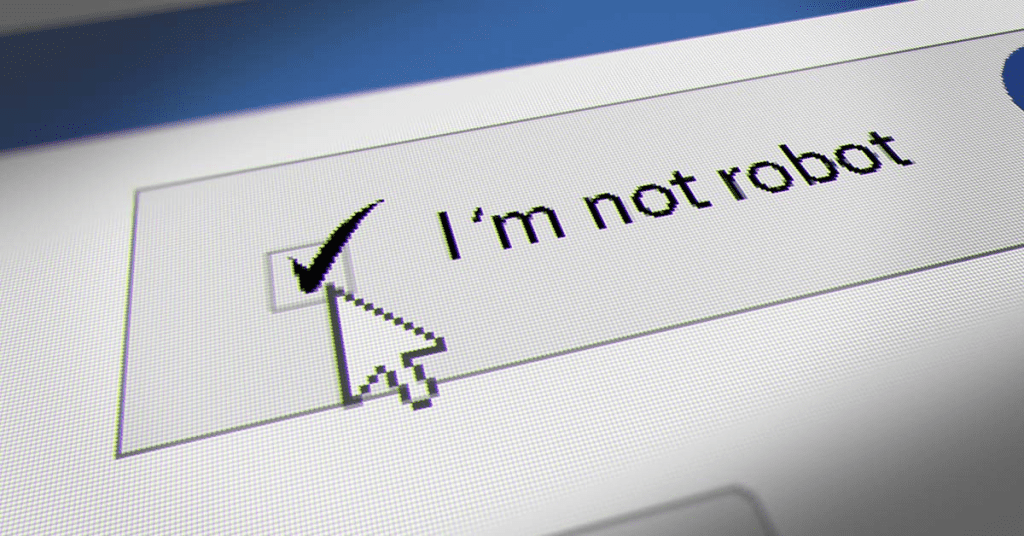If you’ve spent any amount of time browsing the internet, you’ve undoubtedly come across the famous “I am not a robot” checkbox. It’s one of those tasks that we all complete without much thought, believing it’s a simple, straightforward way to prove we’re human. But what if I told you there’s more going on behind that little checkbox than meets the eye? A recently resurfaced video has left many people in disbelief after revealing the truth behind this test, and it’s more invasive than we ever imagined.

What Really Happens When You Click ‘I Am Not a Robot’?
The clip that set the internet ablaze came from a 2020 episode of QI, hosted by Sandi Toksvig. During the episode, Toksvig revealed some surprising facts about the “I am not a robot” checkbox that left both the panelists and viewers stunned. The clip, which was reposted on TikTok by Australian radio presenters Wippa and Fitzy, quickly went viral, amassing millions of views.
What’s so shocking about clicking that checkbox? As it turns out, the test doesn’t just verify whether or not you’re a robot by asking you to tick a box. Instead, it’s analyzing your online behavior in ways you probably didn’t expect.
The Behavior Behind the Box: More Than Meets the Eye
In the QI episode, Sandi Toksvig explains that clicking the “I am not a robot” box is just the tip of the iceberg. The real test happens before you even reach for your mouse. The system analyzes your behavior leading up to the click—things like how you navigate the page, your scrolling patterns, and even the subtle ways you move your mouse across the screen. It’s these behaviors that the system uses to determine whether you’re a human or a bot.
Toksvig added another startling detail: the CAPTCHA system can even look through your browsing history. It uses this data to verify that you’re human, factoring in the types of websites you visit, how long you spend on certain pages, and what kinds of online interactions you have. Watched a few cat videos? Liked a tweet about climate change? These could all be used as indicators that you’re not a bot.
As Toksvig pointed out, it’s a little “spooky” to think about how much data is being analyzed for something as simple as a CAPTCHA.
What Is CAPTCHA Really Meant to Do?
The term CAPTCHA stands for Completely Automated Public Turing test to tell Computers and Humans Apart. Its primary purpose is to distinguish between human users and bots. Bots, which are automated computer programs, often try to hack websites by rapidly inputting password combinations or scraping data. CAPTCHA exists to prevent that.
The idea behind CAPTCHA is that humans possess certain skills that bots typically don’t, like recognizing distorted text or selecting images of fire hydrants from a grid. Bots struggle with these tasks because they rely on algorithms that aren’t as capable of mimicking human behavior—at least not yet.
When you complete a CAPTCHA, you’re helping the system ensure that only real people are interacting with a website. However, it’s not just a simple test anymore. CAPTCHA tests now look at a range of factors, from cookies and cached data in your browser to your location and past behavior. This deeper analysis helps identify whether you’re a legitimate user or a bot trying to gain access to sensitive information.
@theqielves From QI Series R Ep 6 'Ridiculous' with #SandiToksvig #AlanDavies #MaisieAdam #DavidMitchell and #HollyWalsh #QI #QuiteInteresting #robots ♬ original sound – Quite Interesting
Internet Users React: Shock and Disbelief
When this information was revealed, the reactions online were swift and intense. Many people couldn’t believe the level of tracking involved in something they once thought was harmless. One TikTok user did their own research and confirmed the claim: “The first I hear this. Done a quick research, unfortunately it appears true.” Another user expressed their unease, stating, “So a robot is checking if I’m a robot?”
One of the more alarming sentiments came from users concerned about privacy. “Feels like an invasion of privacy, tbh,” one person commented. While most people have accepted a certain level of data tracking online, learning that CAPTCHA systems can access your browsing history raised concerns about how much control we really have over our personal information.

The Tradeoff: Privacy vs. Security
This revelation has sparked an important debate about the balance between privacy and security. CAPTCHA is designed to protect websites from bots that could compromise security systems, steal data, or spread spam. It’s a tool that helps keep users safe in an increasingly complex digital landscape.
However, the price of that security is our personal data. The tracking and analysis that CAPTCHA employs isn’t just about verifying that we’re human—it’s also about gathering information on our online behavior. While this helps websites stay secure, it also opens up questions about how much data we’re unknowingly giving away.
Why CAPTCHA Tests Are Necessary
Despite the concerns, CAPTCHA tests are crucial for protecting websites against bots and automated attacks. Bots can attempt millions of password combinations in seconds, overwhelm sites with requests, or engage in malicious activities that can cripple entire systems. Without CAPTCHA tests, these attacks would be far more common and much harder to defend against.
As John Lloyd, Casaba Security’s Chief Technology Officer, explains, CAPTCHA doesn’t just end once you click the box or solve a puzzle. Afterward, the system checks the user’s cookies, location, and browsing data to assign a score that’s sent back to the web application. This score helps confirm whether the user is legitimate or a bot trying to bypass the system. Once a bot is identified, that information is shared across other websites, creating a ripple effect that helps prevent further bot activity.

What’s Next for CAPTCHA Technology?
As CAPTCHA technology evolves, so do the methods used by hackers to bypass it. Developers are constantly working on ways to improve CAPTCHA’s effectiveness, while also trying to limit its invasiveness. Advanced machine learning techniques are helping CAPTCHA tests become more sophisticated, but this also means more data collection and behavioral analysis.
For now, the tradeoff between privacy and security is something most internet users are willing to accept. But as awareness grows, there may be calls for more transparency in how our data is used in these systems.
Conclusion: A Surprising Reality Behind the Simple Checkbox
The next time you click “I am not a robot,” take a moment to think about what’s really happening behind the scenes. What seems like a simple security measure is actually a complex system that analyzes your online behavior, browsing history, and more to verify your humanity. While CAPTCHA helps keep bots at bay, it raises important questions about the balance between privacy and security in the digital world.
As we continue to navigate the internet, this revelation is a reminder that even the simplest actions can have deeper implications. So, what do you think—are you willing to trade a bit of privacy for online security?


